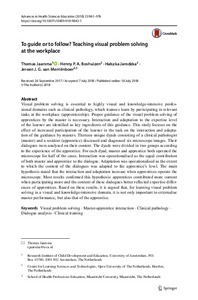To guide or to follow? Teaching visual problem solving at the workplace
Jarodzka H; Jaarsma T; Boshuizen HPA; van Merriënboer JJG
To guide or to follow? Teaching visual problem solving at the workplace
Jarodzka H
Jaarsma T
Boshuizen HPA
van Merriënboer JJG
Julkaisun pysyvä osoite on:
https://urn.fi/URN:NBN:fi-fe2021042823977
https://urn.fi/URN:NBN:fi-fe2021042823977
Tiivistelmä
Visual problem solving is essential to highly visual and knowledge-intensive professional domains such as clinical pathology, which trainees learn by participating in relevant tasks at the workplace (apprenticeship). Proper guidance of the visual problem solving of apprentices by the master is necessary. Interaction and adaptation to the expertise level of the learner are identified as key ingredients of this guidance. This study focuses on the effect of increased participation of the learner in the task on the interaction and adaptation of the guidance by masters. Thirteen unique dyads consisting of a clinical pathologist (master) and a resident (apprentice) discussed and diagnosed six microscope images. Their dialogues were analysed on their content. The dyads were divided in two groups according to the experience of the apprentice. For each dyad, master and apprentice both operated the microscope for half of the cases. Interaction was operationalised as the equal contribution of both master and apprentice to the dialogue. Adaptation was operationalised as the extent to which the content of the dialogues was adapted to the apprentice’s level. The main hypothesis stated that the interaction and adaptation increase when apprentices operate the microscope. Most results confirmed this hypothesis: apprentices contributed more content when participating more and the content of these dialogues better reflected expertise differences of apprentices. Based on these results, it is argued that, for learning visual problem solving in a visual and knowledge-intensive domain, it is not only important to externalise master performance, but also that of the apprentice.
Kokoelmat
- Rinnakkaistallenteet [19250]
